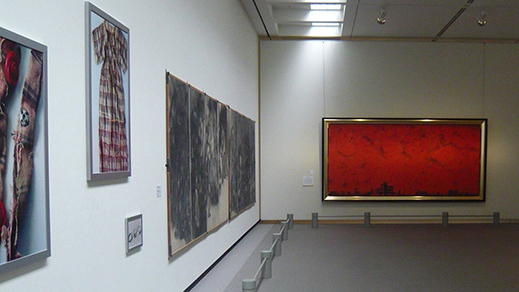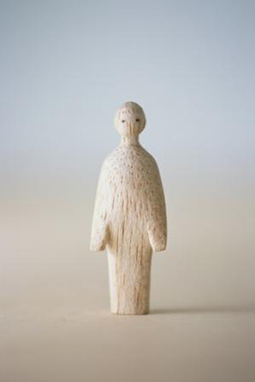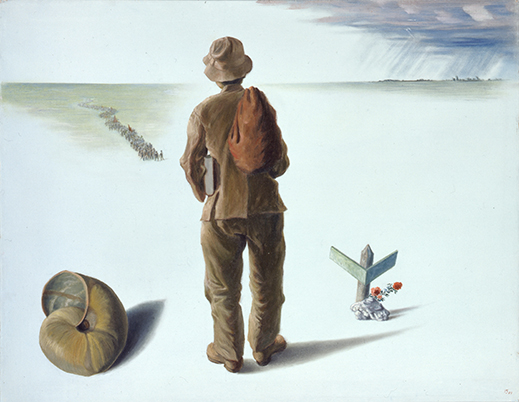 |
| Installation view of Peace Meets Art! at the Hiroshima Prefectural Art Museum. On the far wall is the six-panel Nihonga screen painting The Holocaust at Hiroshima by Ikuo Hirayama. On the left are photos from the Hiroshima series by Miyako Ishiuchi and one of the Hiroshima Panels by Iri and Toshi Maruki. |
Hiroshima is not just the site of the first atomic bombing, but a vibrant regional capital full of parks and rivers -- and several substantial art museums. This summer three of them have collaborated on an ambitious series of concurrent exhibitions, Art Arch Hiroshima 2013, on view until mid-October. It's a good reason to visit a city that has much to offer besides the obligatory nuclear tourism destinations.
Granted, Hiroshima's public culture rarely strays far from the war-and-peace discourse, and this event is no exception. All three museums link their exhibitions in some way to the holocaust of 1945. A common thread is the city's connection to the Japanese-American sculptor Isamu Noguchi (1904-88), who produced several Hiroshima-themed works of public art while in Japan in the early 1950s. The Hiroshima Museum of Art offers an entire show devoted to his oeuvre, while the Hiroshima City Museum of Contemporary Art features his rejected 1952 design for the cenotaph in Hiroshima's Peace Memorial Park as the focal point of its otherwise thematically somewhat scattered exhibition SITE: Places of Memories, Spaces with Potential.
 |
| Motoi Yamamoto, Labyrinth (2013), Hiroshima Prefectural Art Museum, © Motoi Yamamoto. |
The third of the Art Arch shows, however, is all about war, peace, and the Bomb -- and for this very reason is arguably the most successful in its execution. Peace Meets Art!, at the Hiroshima Prefectural Art Museum, brings together a remarkable collection of works by artists who have addressed these concerns directly or indirectly. (Several have been introduced in past issues of artscape Japan; links are provided below.) The exhibition is divided into three sections: "Destruction and Rebirth," "Conversations," and "Art Arch to the Future."
One enters the first section to be confronted by a prominent pair of large-scale attempts to capture the horror of war: Pablo Picasso's Guernica, here in tapestry form, and Taro Okamoto's Myth of Tomorrow, a mural illustrating the devastating power of H-bomb tests in the Pacific (this is a prototype of the even larger final version, which hangs in Tokyo's Shibuya Station). Other standouts are Leonard Foujita's Final Fighting on Attu, depicting a wartime suicide charge by Japanese soldiers; The Holocaust at Hiroshima, a six-panel screen painting of Hiroshima aflame by Nihonga artist Ikuo Hirayama, himself a survivor; one of the Hiroshima Panels by Iri and Toshi Maruki; and photos of clothing worn by bomb victims from the powerful series by Miyako Ishiuchi.
The second section, which purports to be about "conversations" between man and nature or between East and West, seems to bear only a tenuous relationship to the works preceding it, but it does provide some respite from the horrors portrayed in the first section, and perhaps that is the curators' intention. Soothing it is, especially the display of a number of tranquil landscapes in the classical Chinese tradition (as well as one by Grandma Moses!), but it also feels a bit tepid by contrast, some powerful Noguchi sculptures (presumably representing "East-West" dialogue) notwithstanding.
 |
Rei Naito, Hito (2011-12),
courtesy of Gallery Koyanagi. |
The final section achieves a better balance, introducing works by contemporary artists whose concerns with the inner life's response to the outside world offer spiritual sustenance without lulling us into a false sense of peace and security. Two of Japan's finest artists working today, Rei Naito and Motoi Yamamoto, anchor the exhibition with installations that alone are worth the visit. Labyrinth, Yamamoto's room-sized creation, covers the floor with salt, either laid out in exquisite mazelike patterns or piled in snowy peaks. Whether deliberately or not, the rivulets of salt that dissipate into empty space toward the front of the installation vividly recall the rivers crossing Hiroshima's alluvial plain as they divide and flow into the Inland Sea. The entire work evokes the bird's-eye view familiar to all who have seen the photos taken from the air just after the bomb had obliterated the city. Naito's Hito (People) are tiny carved human figures that stand alongside actual shards of glass from bottles melted by the atomic bomb. It's a curious juxtaposition, but somehow it works, poignantly expressing both helplessness and hope in the face of holocaust.
The museum deserves kudos for concurrently running (unfortunately only until September 1) another show that resonated powerfully with the peace-meets-art theme. The Art of Gaman featured works of art and crafts produced by Japanese-Americans interned in camps by the U.S. government during World War II. Indeed, the theme of these exhibitions would be more aptly termed "war meets art," but one has to commend the curators, and the artists, for striving to keep peace in view, even when the odds of achieving it seem daunting at best, even in our own time.
 |
Like a macabre update of Monet's haystacks, bags of grass contaminated with radioactivity stand in a field in Fukushima. From the photography series The World After by Keiko Sasaoka (2012).
|
 |
Noboru Kitawaki, Quo Vadis (1949), National Museum of Modern Art, Tokyo.
All images courtesy of the Hiroshima Prefectural Art Museum. |